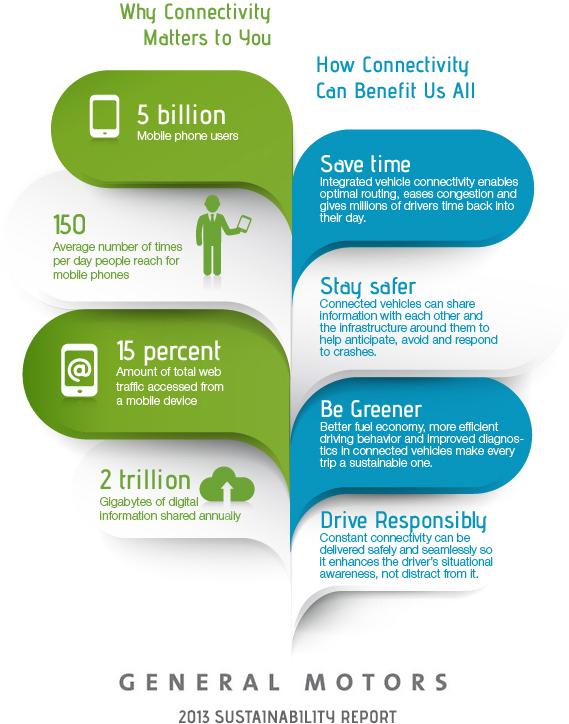Vehicle Connectivity Will Transform Transportation As We Know It

Consider this: There are five billion mobile phone users across the globe.
Those users reach for those phones, on average, 150 times per day, with two trillion gigabytes of digital information shared annually.
That’s a lot of data flowing back and forth.
If we can come up with a way to take advantage of this free-flow of information, at GM we believe it could lead to better fuel economy, more efficient driving behavior, and improved vehicle diagnostics in connected vehicles.
In fact, this is the foundation upon which we’ve built our 2013 corporate sustainability report.
As more people expect their cars to have the technology they use everywhere else in their lives, we satisfy connectivity demands while enabling a more sustainable transportation future.
With 6.5 million vehicles already connected by OnStar, we’re in a good spot.
But population growth, expanding wealth and increasing urbanization mean more cars in already congested cities. Traffic congestion, limited parking space and pollution in large metro areas around the world significantly diminish the value of owning a car.
We need innovation solutions to address these urban mobility challenges, and enhanced connectivity can play a major role.
Smart connectivity can provide real-time information to help reduce consumer uncertainty about travel times and convenience. If these projects result in significantly fewer cars on the road for a given area, then the widespread adoption of these models will likely soon follow.
Better trip routing is an even better avenue for congestion relief. GPS-based navigation apps can turn smartphones into traffic probes, creating a constellation of data about traffic conditions, travel times and optimal routes.
Routing optimization also offers environmental benefits. A longer route with fewer stops and starts can save time and fuel. Similarly, a path with fewer elevation changes may offer meaningful benefits for drivers of electric vehicles.
Waypoint navigation is a unique feature of the Chevrolet Spark EV that helps drivers plan trips using OnStar’s Turn-by-Turn Navigation. The service finds charging stations along the way and recommends charge stops based on the time and mileage to reach the selected destination.
Better vehicle diagnostics can also save fuel.
OnStar data tells us that every month about 30 percent of OnStar subscribers drive with low tire pressure. Diagnostic emails alert these drivers of the condition, and most respond by putting air in their tires. Proper tire inflation is just one way to drive more efficiently. It reduces fuel consumption and extends tire life. These alerts save hundreds of millions of gallons of fuel each year.
To go one step further, the connectivity of electric vehicles, like the Chevrolet Volt and Chevrolet Spark EV, help transform an electrical grid into a “smart grid.”
Our new agreement with TimberRock Energy Solutions is the first to leverage the capability to think of the EV as a battery that can supply power to the grid. The project uses software and solar charging canopies to manage the flower of solar power to benefit the electric grid. Through OnStar’s Demand Response solution, TimberRock can start, stop and modulate the amount of charge reaching a vehicle based on energy need.
Combining renewable energy with the battery storage capabilities of the charging station — all enabled by smart connectivity — is the future of vehicle charging.
Safer vehicles. Less congestion. Better fuel efficiency. A smarter grid. An intuitive customer experience.
At GM, our efforts to realize the potential of customer-driven sustainability are guided by an ambitious agenda. We see few limits to what can be achieved for our customers and how connectivity can translate into a more sustainable transportation future.

